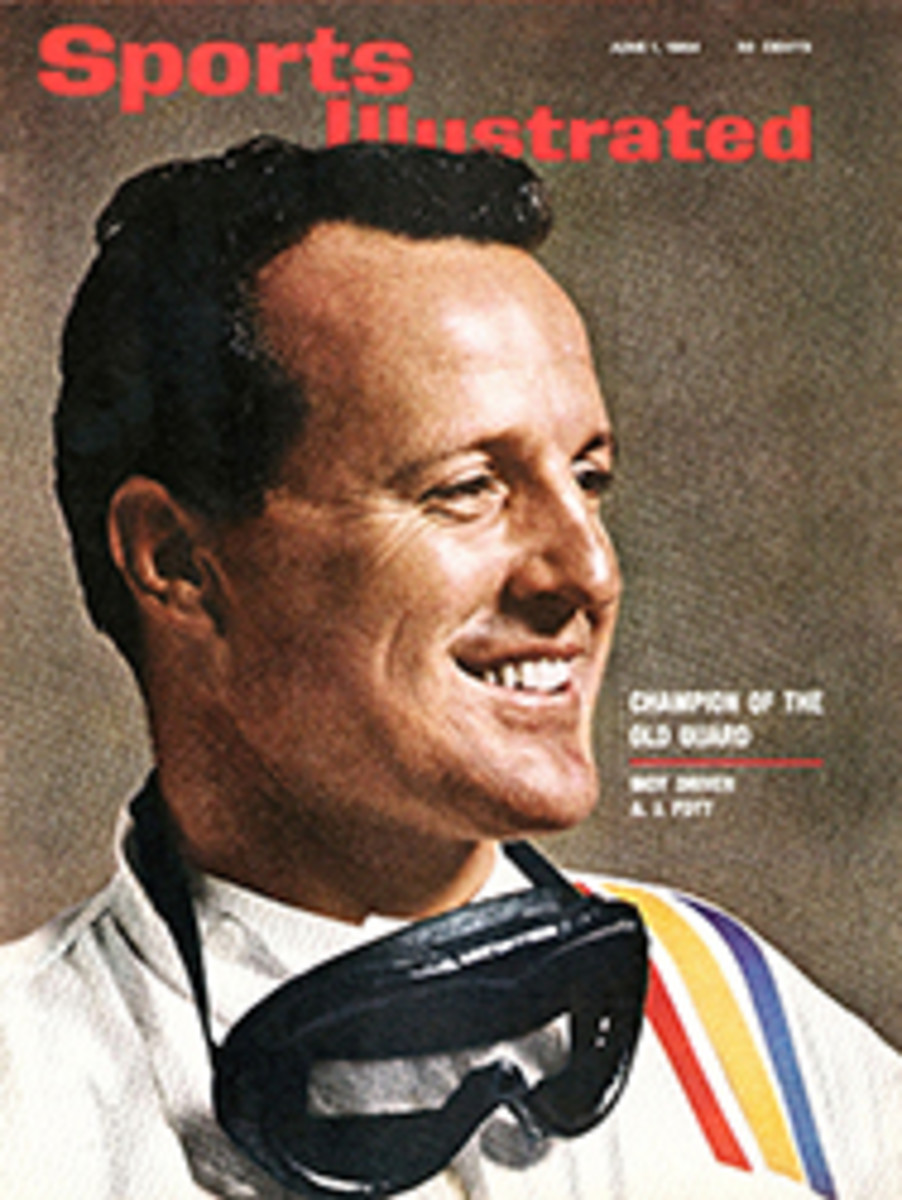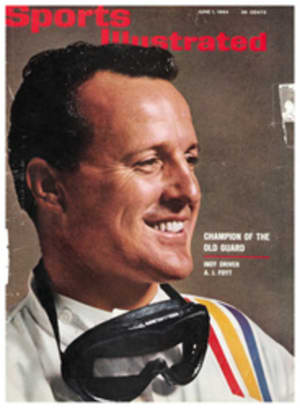
SPEED IN BRIGHT REPOSE
No sporting event on earth has a greater number of parts, bits and pieces than the Indianapolis 500-mile race. As Driver A. J. Foyt (see page 78) and the 32 others prepare themselves mentally for Saturday's 48th "500," their crews with loving, even fanatical, care dismantle and reassemble the racing cars, paint and polish them, fuss and fidget with them and arrange the hundreds of tools, gimmicks and gadgets without which the race cannot be run. Just as the spectators see the race itself in fragments—the track is too big to be viewed as a whole—strollers in the pits and in Gasoline Alley during the month of May absorb the preparatory scene as a kaleidoscope of bright miniatures. They find unending fascination in cars laid open for emergency surgery in the garages and inspect the components of new engine, chassis and suspension designs with rapt and reverent attention. In the Indianapolis sampler on the following pages the camera's eye darts here and there amid that crazy quilt of shapes and scenes, pausing at a car's nose-piece of extravagant hue, the shining skin of an Offenhauser racer, the gloved hands of a keyed-up driver. Anticipation is in every scene: all the parts will come together on race day to compose the sound, speed and fury that make a "500."
NO BUSINESS LIKE GO BUSINESS
The Indianapolis "500" is part racing, part Hoosier picnic and part big business. Business has never been better, as the profusion of product decals on the opposite page attests. The reason is not elusive. The "500" gets bigger and more glamorous every year, and business likes to smear some of that glamour on its products just as a youngster likes to spread strawberry jam on a slice of plain white bread.
There are three basic ways in which business can reach for the jam jar. The first is to sponsor a car. The second is to put up prize money for top finishers using your product. The third is to pay a car owner or driver or both for using your product.
Sponsorship costs up to $7,000 or so for first-rate cars and entitles the sponsor to top billing on the car's flank. Examples: the Kaiser Aluminum Special and the MG Liquid Suspension Special.
Putting up prize money is the old, established entree for accessory companies marketing products that can be used for almost any car: tires, fuel, sparkplugs, piston rings and such. This method became entrenched, and when in recent years some newcomers began paying off in advance and laying on free supplies there was dark talk that they were subverting the American Way.
There still is. Subversion is rife this year. Probably the highest bidders invading the "500" are the oil companies: Humble. Marathon and Pure. Humble has paid an estimated $35,000 to Milwaukee's Bob Wilke (for whom Rodger Ward won the "500" in 1959 and 1962) to ensure that Wilke fills up his two 1964 models with Humble gas and oil. Wilke does not even bother to plead the Fifth Amendment. "I'm all for it," he says. "It helps a first-class operation, and it has done much for racing by helping offset the high cost of development."
Pure takes a more orthodox line by sponsoring Bobby Marshman's Lotus-Ford as the Firebird Special, but Marathon is going Humble's route, grabbing Driver Eddie Sachs by stuffing the pockets of his car's three owners. There is a certain insecurity in this method, as Sachs demonstrated by cracking up the car in practice. (He later repaired the damage and qualified.)
The Humble and Marathon moves have incensed Mobil, long the No. 1 supplier of "500" racing fuel and a staunch "no-deal" standpatter. Mobil continues to offer prize money, chipping in $15,500 toward the record accessory package of $211,000. Pure, Marathon and Humble are by no means pikers in this respect, contributing $35,000, $35,000 and $15,500 respectively.
A similar wrangle involves the tire companies. Although Firestone, pursuing its 41st consecutive victory, faces the stiffest opposition ever, it is playing the game the old way. Firestone does not give away racing tires but sells them at about $250 a set and offers $15,000 in prizes for users of its rubber. Goodyear, an aggressive new participant at Indy, also sells its tires and puts up an identical sum.
The dissenters are Dunlop and Sears, Roebuck. Sears has developed new Allstate racing tires specifically for the speed whiz Mickey Thompson and his three cars and is also sponsoring the cars. Dunlop, the big tire name in international road racing, does at Indy what it does abroad—makes contracts with teams and provides tires gratis. Dunlop supplies the hot new Lotus-Fords of Jim Clark and Dan Gurney, the Brabham built for Tulsa's Jack Zink, and the Novi-powered British Ferguson four-wheel-drive creation.
"This is quite the acceptable way for us, you know," says Dunlop's racing manager, Vic Barlow. "The drivers are paid according to status, and we have found that our fellows in Europe would rather have the money in hand and know what they are going to get than gamble for it."
The quaint custom of slapping decals on the racers started in 1939 with a sticker or two. They have proliferated to such a degree that the U.S. Auto Club, the rulesmaking body for Indy-style racing, has appointed a committee to certify that each of the products so represented is actually used.
PHOTO
MARTIN NATHAN
The freshly painted electric-orange nose of an Offenhauser roadster dries in Gasoline Alley before a pit blackboard used to flash information to a "500" driver.
PHOTO
MARTIN NATHAN
Flamboyant attire is part of the scene, and this picture reveals what happens sartorially when a Westerner becomes associated with a car known as the Orange Juice Special. He naturally puts on orange pants and Sunday boots.
PHOTO
MARTIN NATHAN
Tools are as specialized as a surgeon's. These hammers, laid out on the pit wall, have but one function, and that is to knock wheel-securing wing nuts on and off. Heads of malleable bronze will not damage the magnesium wing nuts.
PHOTO
MARTIN NATHAN
Tires must be instantly available for quick changes. Many crews prop them up like this in the pit lane. A car rolls in. A crewman plucks off the old rubber, pivots to seize a new tire and slaps it on—all in a matter of seconds.
PHOTO
MARTIN NATHAN
Fuel tanks bearing racing alcohol under nitrogen pressure deliver up to 50 gallons in a 20-second stop. After flicking open a quick-release cap (of the kind on the Offenhauser at right), a pit man slams a nozzle in and fills 'er up.
PHOTO
MARTIN NATHAN
Decals splashed along the cars' sides reflect a fight nearly as competitive as the "500" itself, revealing at a glance the accessory products used. Since a "500" victory gives tires and batteries and such an undeniable cachet, there is a sharp rivalry among the accessory people to land the foremost drivers.
PHOTO
MARTIN NATHAN
Among the little things that mean a great deal at Indy are air holes drilled into the roadsters' plastic windshields. Everything on the cars gets hot. Cooling air from these apertures helps keep the driver from cooking in his cockpit.
PHOTO
MARTIN NATHAN
Prerace tension cannot be dispelled by the most elaborate and meticulous preparations. Here Rodger Ward, the 43-year-old master who has twice won the "500," clasps his hands tautly before going to the starting line.
PHOTO
MARTIN NATHAN

